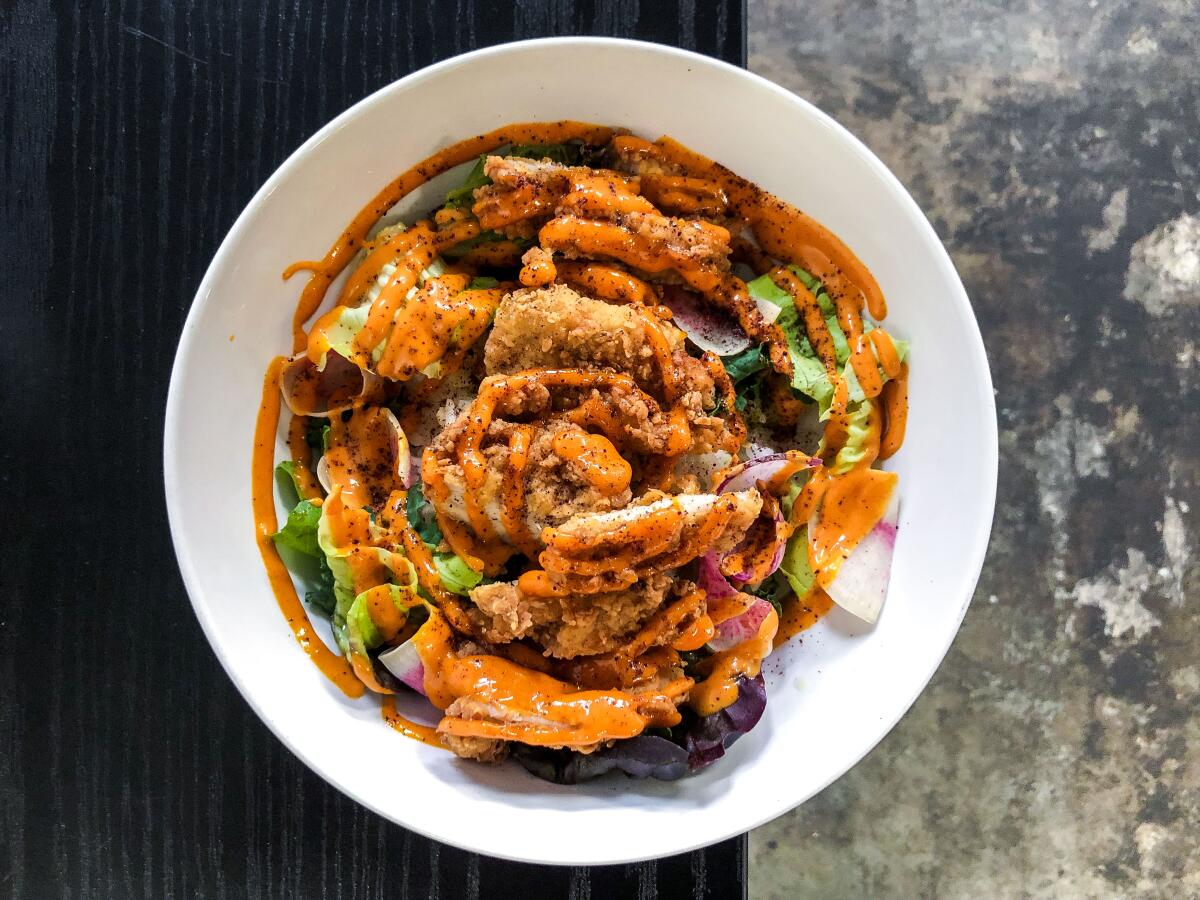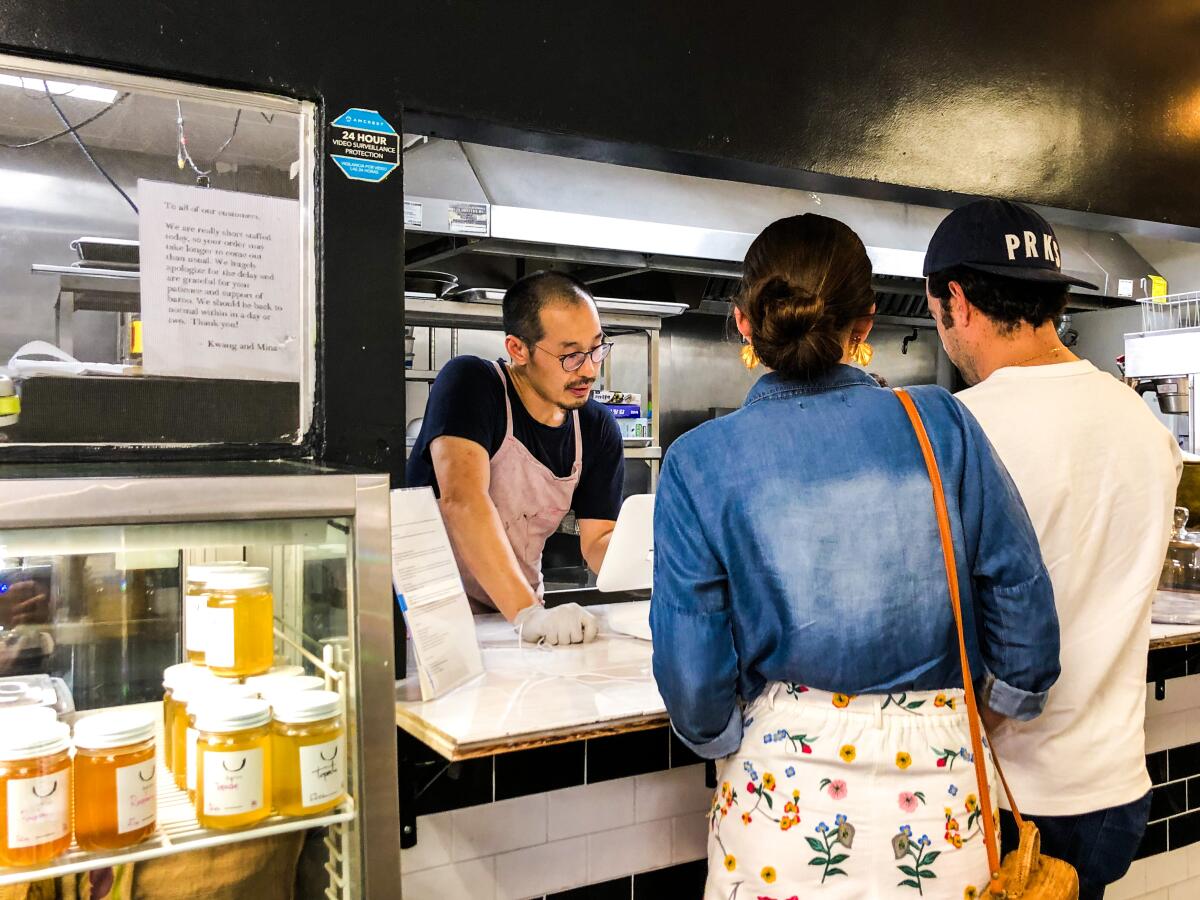Searching for enlightenment at beloved Baroo’s East Hollywood reincarnation

The setting had changed, but the heart of the experience felt entirely familiar. It was 4:30 p.m. on a recent Wednesday inside East Hollywood’s Union Swapmeet. I watched chef Kwang Uh’s straight back as he moved between the stove, fryer and counter at his Baroo Canteen stand. He moved with purpose but still radiated calm. He was finishing a rice bowl garnished with kimchi corn salsa and jalepeño coulis and crowned with fried chicken cutlets.
“I’ll have that, please,” I said after Uh had passed the bowl to the customers waiting for it.
“Oh, that was the last order for the day,” he said serenely.
I asked for a few other things instead, including a rice bowl with octopus. The next customers in line wanted the octopus as well; Uh told them I had nabbed the day’s final order of that dish.
In big and small ways, Uh’s endeavors in Los Angeles have always carried a fundamental message: Everything is temporary.
Like many food obsessives, I felt new synapses fire in my head the first time I had his cooking at the original Baroo. He opened the 16-seat restaurant in a small Hollywood strip mall with childhood friend Matthew Kim in 2015. His food has an unbridled streak of originality: pastas and grain bowls wild with nuts, seeds, broths, pickles, kimchi and other fermented foods. The ingredients flew in a million directions but then landed with clarity — much like the mind can do during meditation. Uh has studied Buddhism; me, too. I wrote about how his cooking reminded me of Buddhist practice in a 2016 review. Uh met Mina Park, his wife and business partner, at the South Korean temple resided by Jeong Kwan, the Zen nun made famous when she was featured on an episode of Netflix’s Chef’s Table.
Baroo was opened and closed in fits and starts and finally ended its run in October 2018. While Uh and Park plot a full-service restaurant, Baroo Canteen is their transitional vehicle; it continues to deliver lessons in impermanence. Union Swapmeet, in business since 1986, will be demolished in the next year to make way for a new residential and retail development. The marketplace is starting to look forlorn, with empty stall spaces and quiet afternoons.

Uh has dialed back the complexity of his dishes, but eating his food still affects the brain like taking trigonometry and music-appreciation classes in the same hour. As a starter, he makes a riff on Hong Kong-style shrimp toast, sweet and crisp and surrounded with dots of pureed avocado and yuzu coulis. My colleague Jenn Harris wrote of her love for Uh’s pastrami fried rice; it had been blotted from the list of dishes that day. That octopus bowl? Its assembly includes Koda Farms Kokohu Rose rice flecked with sheep’s purse, an herb with a spiciness akin to mustard greens; in-rotation pickles and kimchi; soy infused with Korean medicinal herbs (the taste had a faraway and not unpleasant astringency); and a fried egg with a handsomely oozy yolk.
Since Uh seemed to be running out of food late-afternoon, I returned the next day at the reasonable lunch hour of 12:30 p.m. No more octopus bowl on the menu, but the fried chicken number was once again available — a generous portion of battered bird amid greens, atop rice and swirled lavishly with kewpie mayo given a jolt via gochujang.
Message received. I will show up earlier to visit Baroo Canteen while it exists in its current transient state. I have a feeling that even when Uh and Park find a “permanent” home for their restaurant, it will still somehow embody flux and change. It’s in their nature.
ASK THE CRITICS
How often do you visit a restaurant before writing a review?
— @tiapet712, Instagram
I dine at a restaurant at least three times before writing a full review — all paid for, of course, by The Times, and I don’t take the budget that allows me such depth of research for granted. Having the resources to perform restaurant criticism fairly is an ever-increasing rarity in all forms of print journalism, sadly, but it’s important.
Critics should go to restaurants multiple times to make a balanced assessment: Was the cooking and the tone of service consistent? Were there types of dishes, consumed at more than one sitting, that particularly showed the strengths and weaknesses of the kitchen team? If it’s a new place (which is most of the time), did the experience evolve over the weeks as the restaurant found its footing? I should say here, too, that I wait at least one month — often longer — before I dive into review visits.
Also, beyond fair and informative, a restaurant review needs to be a compelling read. Visiting a restaurant one time is an impression; returning several times builds a narrative and helps me tell a richer story.
Have a question for our critics? Ask here.
TOP STORIES

This week, the food section was devoted entirely to a commemoration of Jonathan Gold, who died last year on July 21. Here’s what you can find inside:
- Food editor Peter Meehan annotates some of Gold’s most memorable stories. (I’d forgotten what a masterpiece “Fallen Fruit” was — that kicker!)
- A collection of Goldisms: references to “The Graduate,” Green Hornet and Gesamtkunstwerk right this way.
- His most fondly remembered dish as a home cook? Fried chicken (with recipe).
- And readers weighed in, remembering Gold-approved recipes including cornmeal waffles, barbacoa de pollo and potato latkes.
One more thing! Join my colleagues Andrea Chang, Jenn Harris, Lucas Kwan Peterson and Ben Mims for Over Coffee: In Conversation with the Los Angeles Times Food Team. It’s happening Saturday, July 27, at Redbird downtown, 10-11:30 a.m. Tickets are only $5!
More to Read
Eat your way across L.A.
Get our weekly Tasting Notes newsletter for reviews, news and more.
You may occasionally receive promotional content from the Los Angeles Times.








